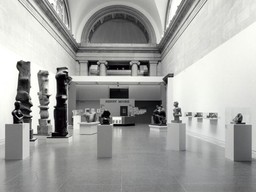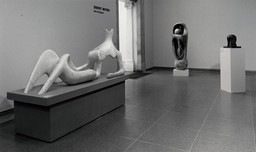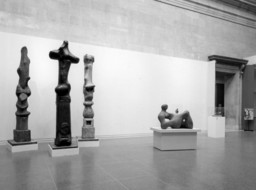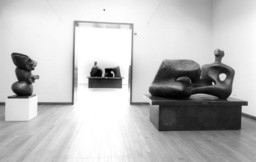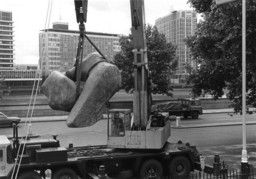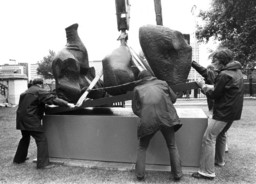Critical Voices: Artists’ Responses to Moore’s Gift to Tate in 1967
Alice Correia
In 1967 the announcement of Moore’s intention to give a selection of his large-scale sculptures to the Tate Gallery elicited both praise and, among many younger artists, consternation. The ensuing debate about the gift raised difficult issues about the appropriateness of such prominence being given to a single artist by a national museum and the role of a small elite in making these decisions.
On 27 February 1967 the Times published on its front page the news that Henry Moore planned to give a sizable number of his sculptures to the Tate Gallery.1 The gift was reported to include major works as well as a selection of sketchbooks, and was speculated to be worth as much as £1 million. Speaking to journalist Peter Hopkirk, Moore stated, ‘it is my firm intention to give between 20 and 30 major pieces of my work to the Tate. In my own mind I have made an initial selection, though this may be modified after talks with the director of the Tate, Mr. Norman Reid’.2 The Times noted that it was a condition of the gift that the works ‘should be adequately displayed and that there should be no question of basement storage or such partial display as in the past made for an inadequate representation of Turner’s bequest’.3 The article also speculated that ‘a special Moore gallery will perhaps form part of the building extensions in prospect for the Tate’, and expressed the hope that the gift would at least serve as an incentive to get the building work of the proposed Tate extension underway.
In the following days, weeks and months, a series of letters published in the correspondence pages of the Times highlighted concerns regarding Moore’s reported stipulations that his gift be displayed at Tate in its entirety and in perpetuity. One of the first responses was written by the sculptor Sir Charles Wheeler, former President of the Royal Academy. Although Wheeler did not question the generosity of Moore’s gift, he hoped that the Tate Gallery would be able to accept the sculptures without the specified conditions.4 Noting that Tate had faced problems when it accepted other bequests with similar stipulations, he wrote, ‘the reasons why such a binding undertaking is unwise is obvious. Outlooks, and values therefore, change with the passage of the years ... No one can forecast the judgment of future generations’.5 Musing on the changing fortunes of artistic reputations, Wheeler observed that in his youth the Tate Gallery had been full of paintings by George Frederick Watts, works that now languished in the gallery’s cellars. He concluded his letter with the hope that Moore would leave the final assessment of his work to the ‘Hands of Time’. The ‘“great works” of today may become the “bronze oddities” of tomorrow. Then it would be necessary to move them and so make room for new “great sculptures”. This is the way we progress. No dead hand should attempt to stop us’.6 Wheeler’s use of the phrase ‘bronze oddities’ could suggest an underlying hostility towards Moore’s works and some recent commentators have seen his letter as a ‘reactionary establishment outburst’ made by an older, figurative sculptor.7 But such interpretations overlook his main point that artists should not attempt to control their reputations. In his defence Sarah Crellin argued in 2012 that Wheeler’s position was in tune with that of a younger generation who sought to repudiate Moore’s elevated position as the ‘father’ of British modern art.8
The question of where and how Moore’s gift would be displayed became particularly heated following a speech at the Royal Academy’s annual dinner in April 1967 by the Prime Minister, Harold Wilson. Wilson praised Moore for the generosity of his gift and pledged a grant of £200,000 from the Treasury towards the cost of building the planned extension at the Tate Gallery. As Moore’s biographer Roger Berthoud observed, ‘the way he [Wilson] had blurred together the display of the Moores and the funding of the Tate extension was to prove very troublesome’, for the impression was given that the planned extension was to be for the display of Moore’s works.9 A few weeks after Wilson’s announcement no less than forty-one British artists signed an open letter to the Times expressing concern about the prospect of the Tate Gallery dedicating a large portion its gallery space and consequently large sums of public money to the work of a single artist. Published on 26 May 1967, the letter argued that such moves were contrary to the mission of the museum and to the ethos of modern art:
Reference has been made in the press and in public during the last few weeks concerning the offer made by Henry Moore to the Tate of between 20 and 30 major works. We understand that the Government will be giving £200,000, and that the Tate will be raising an equivalent sum specifically towards housing these works.
We must not lose sight of the fact that this £400,000, probably only a starting figure, is public money: and considering how public this whole matter should be there has been little precise information available. What can be deduced should be viewed with concern.
We may assume that at least half the gift will be large works. These alone properly displayed would require a space twice the size of the present sculpture hall. Even if the permanent display of these pieces is not envisaged the question of storage is equally crucial.
There are great priorities confronting public patronage of the arts. The Tate has only limited space into which to expand and in which to fulfil its role as the only permanent manifestation of a living culture. London has failed so far to provide itself with museum facilities commensurate with its importance as an art centre and it will not achieve its proper place as an organic part of our world by devoting itself so massively to the work of a single artist.
Whoever is picked out for this exceptional place will necessarily seem to represent the triumph of modern art in our society. The radical nature of art in the twentieth century is inconsistent with the notion of an heroic and monumental role for the artist and any attempt to predetermine greatness for an individual in a publicly financed form of permanent enshrinement is a move we as artists repudiate.10
The letter was signed by Craigie Aichinson, David Annesley, Gillian Ayres, Anthony Benjamin, Derek Boshier, Anthony Caro, Patrick Caulfield, Bernard Cohen, Harold Cohen, Garth Evans, Sheila Fell, Elizabeth Frink, Patrick George, Anthony Hill, Howard Hodgkin, Malcolm Hughes, Gwyther Irwin, Tess Jaray, Allan Jones, Michael Kinder, Phillip King, John Latham, Francis Morland, Henry Mundy, Myles Murphy, Eduardo Paolozzi, John Plumb, Tim Scott, Peter Sedgley, Peter Snow, Peter Startup, Joe Tilson, William Tucker, William Turnbull, Michael Tyzack, Euan Uglow, Marc Vaux, Brian Wall, Gillian Wise, Anthony Wishaw, and Brian Young. Moore was later informed that Bernard Cohen had been the main instigator of the letter, but Cohen later commented, ‘to say that I was made the fall guy is putting it mildly ... I was one of a considerable number of people responsible’.11
Many of the signatories were leading figures in Britain’s art schools12 and could easily be regarded as vocalising the opinions of a younger generation engaged in a radical reconceptualisation of art. Many of the sculptors who had signed the letter were involved in rethinking how sculpture could be made and were reframing it as kinetic, performed, and immaterial. In 2014 Peter Sedgley reflected that there was:
a developing self-assurance among ... artists which encouraged them to speak out in defence of not only the innovation of their work but also a changing social climate in which they were actively taking part. Heavy handed, authoritarian and undemocratic behaviour by the ‘Establishment’ was under review and led later to the quasi revolutions in schools and universities in Britain and Europe.13
Although radical changes were being made to how art was taught, practiced and displayed during the 1960s, mainstream ‘galleries continued to function ideologically, affirming institutional power and authority’, according to historian and critical theorist Gillian Whitely.14 For art historian Margaret Garlake, the 1960s ‘Establishment’ was a ‘powerful web of contacts ... a small number of people connected through their membership of committees’, who sought to uphold particular artists, styles and values.15 On publication of the artists’ letter the art world elite came to Moore’s defence.
Moore’s supporters, who included the former directors of the National Gallery, Kenneth Clark and Philip Hendy, regarded the letter as a personal attack on the artist, his work, and his importance to British modernism. Throughout the 1950s and early 1960s Moore had enjoyed the support of influential art world figures and had had his work exhibited around the world by the British Council. In the popular press and on television he was almost routinely acclaimed as Britain’s ‘greatest’ artist. However, younger artists, who looked to American and European art for inspiration, felt alienated by the reverence shown to Moore and questioned the contemporary relevance of his work. On the occasion of Moore’s solo exhibition at the Whitechapel Gallery, London, in 1960, Caro wrote in the Observer that Moore may have paved the way for the next generation of artists but had ‘paid heavily for his stardom’.16 ‘My generation abhors the idea of a father-figure’, he explained, ‘and his [Moore’s] work is bitterly attacked by artists and critics under forty when it fails to measure up to the outsize scale it has been given’.17
According to Moore’s biographer Roger Berthoud, ‘to Moore the letter reeked of ingratitude and disloyalty, and amounted to a public rejection’.18 Moore was particularly pained that the signatories included Caro and Phillip King, who had worked as his assistants early in their careers.19 Moore had also long considered himself as a supporter of young artists and had championed the acquisition of work by several of the signatories while a Trustee of the Tate Gallery. And as executor of the estate of Peter Gregory, Chairman of Lund Humphries publishing house, he had selected works by Caro and Paolozzi for Tate’s collection in 1959.20
Moore refrained from responding publicly to the letter but the Trustees of the Tate Gallery quickly sought to correct the errors in the Times’s initial report of Moore’s gift and the misunderstandings generated by Wilson’s speech. In a letter to the Times Chairman of the Board of Trustees, Anthony Lousada made the point that the government’s donation of £200,000 towards a new extension was not tied to Moore’s gift and that Moore had not stipulated that the gifted works be on permanent display.21 Nonetheless, as art historian Frances Spalding has noted, ‘if a misunderstanding had been corrected, a distrust of an individual artist’s desire for aggrandisement remained’.22
This may have been exacerbated by Moore’s supporters. Kenneth Clark wrote to the Times, noting that Giotto, Masaccio and Michelangelo had been recognised and celebrated as great artists who were heroic in their individual contributions to the evolution of art. He concluded, ‘if we believe that Henry Moore has fulfilled this role in our day we are surely right to make his work available to posterity in a worthy manner’.23 In its tone and content, Clark’s letter was a rebuke to those artist signatories who had criticised the concept of individual pre-eminence, and he sought to position Moore alongside artists whose revered position within the history of art was incontestable. If Wheeler had regarded Moore’s attempts at ensuring his reputation as objectionable, Clark’s positioning of Moore as a genius comparable to Michelangelo would have been galling to many others.
However, Moore also found supportive voices unlikely quarters. One of the most robust defences of Moore came from the abstract artist Victor Pasmore, who wrote to the Times on 1 June 1967:
if the decision to establish what will amount to a monument to a British artist who is now recognized internationally as one of the great modern sculptors and who, as a result has raised the prestige of British art to a level of international recognition which it has not enjoyed since the days of Turner seems a little hasty; then so is the implication raised in the letter that Moore is not worthy of this distinction.
Furthermore it is simply not true to say that the nature of modern art is inconsistent with the notion of a heroic role for the artist ... Modern art has been the product of a series of liberating forces initiated in the first instance by the Romantic Movement: as such it has been dependent on a continuous and escalating process of heroic acts on the part of individual artists. That Henry Moore has provided a major contribution to this process there can be no question.24
Following its publication, several of the original signatories of the group letter wanted to move the debate away from Moore and the question of whether he was worthy of dedicated gallery space at the Tate. In a letter to the Times painter Myles Murphy, for example, highlighted the issue of the need for a museum of modern art to be both comprehensive and adventurous, and the difficulty posed in this by the Tate’s relative lack of space for expansion:
all national museums must be comprehensive and representative within their terms. A museum of modern art must also be radical. It must also remain so. It is in the nature of events for institutions to lose their radical elements and the physical conditions on which they are dependent to become confined and inflexible. This danger is even more when, as at the Tate, the possible future development is severely limited.25
As Phillip King explained in 1984, ‘the fear was that the Tate would be flooded with Henry Moores and there wouldn’t be room for everyone else: there was a rumour that Henry Moore was going to take over all the new space. It [the letter] was more addressed to the Tate than to anyone else’.26
On learning how upset Moore was about the letter, Caro and King visited Moore at his home and attempted to explain that it had not been meant as a personal attack. Although they were keen to salvage their relationships with Moore, they would also have been aware of the influence he wielded and the value of retaining his goodwill. On 27 September, just four months after the original letter was published, Lousada wrote to Moore soliciting his approval of King’s nomination as a Tate Trustee:
As you know, the Tate Board is required to include a certain number of practising artists. We have decided that it would be a good thing to have one of the younger generation. We therefore made certain recommendations and from them I think it is likely that Phillip King will be appointed by the Prime Minister.
I had a reservation about him as he had signed the letter which we disapproved of so much in the Times. I therefore saw him before any question of this was in the air and in general conversation I raised this with him. He told me that he had gone down to see you with Caro and that the visit had ended in a friendly way. He also told me that he regretted having signed the letter and after much thought I felt that it would be a mistake to continue to hold this against him. I therefore hope you will not mind.27
In the summer of 1968 the Tate Gallery staged a solo exhibition of Moore’s work, curated by the critic David Sylvester, to mark the artist’s seventieth birthday.28 Although King and Caro repaired their relationships with Moore and the Tate,29 in an extended article promoting Moore’s exhibition, Phillip Hendy reproached the letter’s signatories, reflecting that,
continental worship of ‘the master’ may sometimes have an unctuous quality, but there is a generosity about it which has brought its own reward in the essential thing which has been lacking here. It would have been better if the signatories to the letter had paused to ask themselves where they would have been without Henry Moore. Of course every phase of his work has been imitated by someone or other the world over, but it is much too early to say whether others will be able to maintain the art of sculpture on the plane to which he has raised it.30
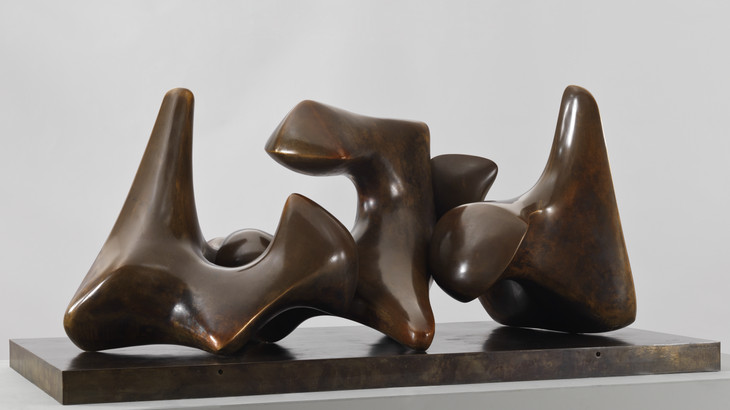
Henry Moore OM, CH 1898–1986
Working Model for Three Piece No.3: Vertebrae 1968, cast c.1968
Bronze
object: 1080 x 2360 x 1220 mm, 948 kg
Tate T02303
Presented by the artist 1978
© The Henry Moore Foundation. All Rights Reserved
Fig.1
Henry Moore OM, CH
Working Model for Three Piece No.3: Vertebrae 1968, cast c.1968
Tate T02303
© The Henry Moore Foundation. All Rights Reserved
it is not easy for a young English sculptor to evaluate Moore’s work and I suppose many people would ask if it is necessary. The protective fury aroused by Anthony Caro’s Observer article and the recent letter from a group of younger artists in The Times, indicate that it is impossible to discuss Moore’s position and achievement without being accused of disloyalty, even treachery. In the long term Moore’s reputation cannot be enhanced by the absence of any debate on the importance of his work. If it has the quality that is claimed for it, it can surely protect itself.33
That the controversy over Moore’s gift to the Tate continued to reverberate a year later demonstrated the extent to which the artists’ letter highlighted a real division within the art world. Establishment figures defended Moore and attempted to shame his younger critics for their ingratitude and lack of respect for his achievements, while an emerging generation of artists and writers wanted to dismantle established canons of art based on notions of the heroic artist-genius. The artists’ letter to the Times, and responses to it, were illustrative of not simply a generational shift but also of an ideological schism in the way art and artists were discussed and celebrated in late 1960s.
Notes
Ann Compton, ‘Affirmative Action: British Sculptors and Sculpture and the Monographic Form in Twentieth-Century Sculpture Studies’, Sculpture Journal, vol.22, no.2, 2013, p.78. See also Hilary Spurling, ‘The Turbulent Reputation of Henry Moore’, Guardian, 27 February 2010, http://www.theguardian.com/artanddesign/2010/feb/27/henry-moore-sculpture-tate-britain , accessed 25 January 2015.
For example, Caro led the Advance Sculpture course at St. Martin’s College, London, and by the mid-1960s his students Annesley, King, Scott and Tucker were also on the teaching staff.
Peter Sedgley, correspondence with the author, 31 December 2014. See Tate’s Art School Educated research project and video recordings of the 2014 ‘Reflections on the Art School’ conference, http://www.tate.org.uk/whats-on/tate-britain/conference/art-school-educated-conference , accessed 30 January 2015. David Hulk’s ‘Going with Change: The Impact of Curriculum Reform at St Martin’s School of Art’ is of particular relevance, http://www.tate.org.uk/context-comment/video/reflections-on-art-school-video-recordings#open241072 , accessed 30 January 2015.
Gillian Whitely, ‘On Common Ground: Sculpture and the Viewing Subject’, in Penelope Curtis (ed.), Sculpture in 20th-Century Britain: Volume 1: Identity, Infrastructures, Aesthetics, Display, Reception, Leeds 2003, p.187.
Ibid. Caro worked as Moore’s studio assistant from 1951 to 1953, while Phillip King did so from 1958 to 1960.
See Anthony Caro, Woman Waking Up 1955 (Tate T00264) and Eduardo Paolozzi, Shattered Head 1956 (Tate T00273). For information about Gregory see http://www.lundhumphries.com/default.aspx?page=5113 , accessed 20 December 2014.
How to cite
Alice Correia, ‘Critical Voices: Artists’ Responses to Moore’s Gift to Tate in 1967’, in Henry Moore: Sculptural Process and Public Identity, Tate Research Publication, 2015, https://www

